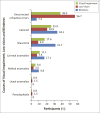Prevalence and causes of visual impairment in patients seen at Nkhensani Hospital Eye Clinic, South Africa
- PMID: 26842521
- PMCID: PMC4729124
- DOI: 10.4102/phcfm.v7i1.728
Prevalence and causes of visual impairment in patients seen at Nkhensani Hospital Eye Clinic, South Africa
Abstract
Background: Knowledge of the prevalence and causes of visual impairment (VI) amongst hospital patients is useful in planning preventive programmes and provision of eye-care services for residents in the surrounding communities.
Aim: The aim of this study was to determine the prevalence and causes of VI amongst eye clinic patients at Nkhensani Hospital. The relationship between VI and age was also investigated.
Setting: Nkhensani Hospital in the Greater Giyani subdistrict municipality, Mopani district, Limpopo Province, South Africa.
Methods: Four hundred participants aged 6-92 years were selected for the study using a convenient sampling method. Presenting and best corrected visual acuities (VA) were measured with a LogMAR E chart. Presenting VA (PVA) in the right and left eyes and in the better eye of the patients was used to determine the prevalence of VI, low vision (LV) and blindness. Ophthalmoscope was used to diagnose the eye conditions causing VI amongst participants.
Results: The prevalence of VI based on the PVA in the right eye was 34.8% and in the left eye, the prevalence was 35.8%. There was a significant association between age of the participants and VI in the right and left eyes (p = 0.00) in each case, respectively. Based on the vision in the better eye of each patient, the prevalence of VI was 28.0% and there was a significant association between VI and age of the participants (p = 0.00). The main causes of VI were uncorrected refractive errors, cataract and glaucoma.
Conclusion: Findings in this study indicate that a large proportion of VI is preventable. Focusing on refractive error correction and surgical intervention for cataract would significantly reduce the burden of VI amongst patients utilising this hospital.
Fréquence et causes de déficience visuelle chez les patients examinés à la Clinique phtalmologique de l'Hôpital Nkhensani, Afrique du Sud.
Contexte: Une connaissance de la fréquence et des causes de déficience visuelle (VI) chez les patients des hôpitaux est utile pour mettre en œuvre des programmes de prévention et des services de soins oculaires pour les habitants des communautés avoisinantes.
Objectif: Le but de cette étude était de déterminer la fréquence et les causes de VI chez les patients de la clinique ophtalmologique de l'Hôpital Nkhensani. On a aussi examiné la relation entre la déficience visuelle et l'âge.
Cadre: L'hôpital Nkhensani dans la municipalité du sous-district du Greater Giyani, district de Mopani, province du Limpopo, Afrique du Sud.
Méthodes: Pour l'étude on a sélectionné quatre cent participants âgés de 6 à 92 ans et utilisé une méthode pratique d'échantillonnage. On a mesuré les acuités visuelles présentes et la meilleure acuité visuelle corrigée (VA) au moyen d'un tableau LogMAR E. On s'est servi de la (PVA) dans l'œil droit et l'œil gauche et dans le meilleur œil des patients pour déterminer la fréquence de VI, la vision basse (LV) et la cécité. On a utilisé un ophtalmoscope pour diagnostiquer les conditions oculaires causant la VI chez les participants.
Résultats: La fréquence de VI basée sur la PVA dans l'œil droit était de 34.8% et dans l'œil gauche elle était de 35.8%. Il y avait une relation significative entre l'âge des participants et la VI dans l’ œil droit et gauche (p = 0.00) dans tous les cas, respectivement. En se basant sur la vision du meilleur œil de chaque patient, la fréquence de VI était de 28.0% et il y avait une relation significative entre la VI et l'âge des participants (p = 0.00). Les causes principales de VI étaient des erreurs de réfraction non corrigées, la cataracte et le glaucome.
Conclusion: les résultats de cette enquête montrent qu'une grande proportion de VI peut être évitée. En mettant l'accent sur la correction des erreurs de réfraction et les interventions chirurgicales pour la cataracte, on réduirait beaucoup le fardeau de la déficience visuelle chez les patients de cet hôpital.
Figures
References
-
- World Health Organization (WHO) Visual impairment and blindness. Fact Sheet No. 282, updated August 2014 [page on the Internet]. c2014 [cited 2014 Aug 18]. Available from: http://www.who.int/mediacentre/factsheets/fs282/en/
-
- Resnikoff S, Pascolini D, Mariotti SP, et al. . Global magnitude of visual impairment caused by uncorrected refractive errors in 2004. Bull World Health Organ. 2008;86(1):63–70. http://dx.doi.org/10.2471/BLT.07.041210 - DOI - PMC - PubMed
-
- Pascolini D, Mariotti SP. Global estimates of visual impairment: 2010. Brit J Ophthalmol. 2012;96(5):614–618. http://dx.doi.org/10.1136/bjophthalmol-2011-300539 - DOI - PubMed
-
- Schellini SA, Durkin SR, Hoyama E, et al. . Prevalence and causes of visual impairment in a Brazilian population: The Botucatu Eye Study. BMC Ophthalmol. 2009;9:8 http://dx.doi.org/10.1186/1471-2415-9-8 - DOI - PMC - PubMed
-
- Ramke J, Palagyi A, Naduvilath T, et al. . Prevalence and causes of blindness and low vision in Timor-Leste. Br J Ophthalmol. 2007;91(9):1117–1121. http://dx.doi.org/10.1136/bjo.2006.106559 - DOI - PMC - PubMed
MeSH terms
LinkOut - more resources
Full Text Sources
Other Literature Sources
Medical
Miscellaneous

